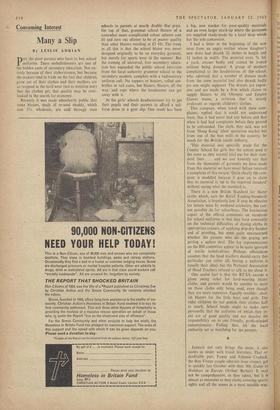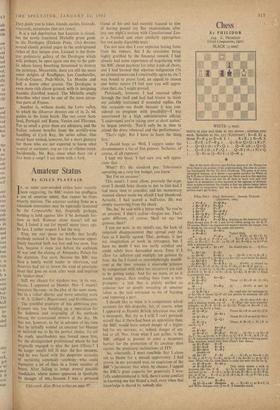Consuming Interest
Many a Slip
By LESLIE ADRIAN
n1TY the poor parents who have to buy school r uniforms. These embellishments are one of the hidden costs of secondary education. Not en- tirely because of their elaborateness, but because the makers tend to trade on the fact that children. grow out of their clothes and their mothers are so resigned to the hard wear (not to mention tear) that the clothes get, that quality may be over- looked in the search for economy.
Recently it was made abundantly public that some blazers, made of re-used shoddy, which cost 37s. wholesale, are sold through state schools to parents at nearly double that price. On top of that, grammar school blazers of a somewhat more complicated colour scheme cost £6 and turn out oftener to be of poorer quality than other blazers retailing at £3 10s. The irony in all this is that the school blazer was never designed originally to be an everyday garment, but merely for sports wear in the summer. But the coming of universal, free secondary educa- tion has expanded the public school imitation from the local authority grammar school to the secondary modern, complete with a rudimentary uniform cult. No toppers or boaters, rolled um- brellas or tail coats, but blazers, blazers, all the way, and caps where the headmaster can get away with it.
At the girls' schools headmistresses try to get their pupils and their parents to afford a uni- form dress or a gym slip. One result has'been a. big, new market for poor-quality materials and an even larger mark-up where the garments are supplied ready-made by a local shop which has the sole concession.
1 had a letter at the beginning of the neW term from an angry mother whose daughter's new dress had shrunk 21 inches in length and 1 inches in width. The material costs 7s. 6d. a yard, creases badly and cannot be ironed
without being damped. A group of mothers complained to the headmistress of the, school, who admitted that a number of dresses made
from the same material had also shrunk badly (as one might suppose). The dresses are expen- sive and are made by a firm which claims to supply blazers to the Olympic and Empire Games teams, a criterion that is strictly irrelevant as regards children's clothes.
This company, when taxed with these com- plaints, replied that it could not understand them, that it had never had any before and that when it had had complaints before they proved to be unfounded. The cloth, they said, was not from 'Hong Kong' (their quotation marks) but from one of the best mills in the country. So much for the British textile industry.
`This material was specially made for the County School for girls but the cotton used is the same as they normal [sic] use for their stan- dard lines . . . and we can honestly say that from the thousands of garments we have made from this material we have never before received a complaint of this nature.' Quite clearly the com- pany is muddled because it goes on to claim that its material is `up to the required standard' without saying what the standard is.
There is a new British Standard for blazer cloths which, says the Retail Trading-Standards Association, is hopelessly low. It may be effective for leisure wear by weekend cricketers, but can- not possibly do for schoolboys. The fascinating aspect of the official comments on standards for school uniforms is that they harp constantly on the technical difficulties of dyeing cloths in appropriate colours, of applying drip-dry finishes and of proofing, but seem quite unconcerned whether the parents who do the paying are getting a sqdare deal. The lay representatives on the BSI committee appear to be quite ignorant of textile technicalities. Perhaps officialdom assumes that the head teachers should carry this particular can (after all, having a uniform is usually their idea), but the National Association of Head Teachers refused to talk to me about it.
One useful fact is that the RT-SA awards a green swing ticket for hard-wearing blazer cloths, and parents would be sensible to insist on those cloths only being used, even though they arc more expensive. Equally sensible: abol- ish blazers for the little boys and girls. The older children do not punish their clothes half as much. School heads ought to make sure personally that the uniforms on which they in- sist are of good quality and not devolve the responsibility on to one friendly, profit-minded concessionaire. Failing that, let the local authority act as watchdog for the parents.
January not only brings the snow, it also snows us under with travel literature. That re- doubtable pair, Fanny and Johnnie Cradock, the Bon Viveur couple who are bons vivants, got in quickly last October with their 50s. Guide to Holidays in Europe (Arthur Barker). It may not be comprehensive, as they admit, but it is almost as extensive as they claim, covering sports, sights and all the senses in a most sensible way.
They gitide you to lakes, islands, castles, festivals, vineyards, mountains (but not caves).
It is a sad deprivation that Lascaux is closed, but the newly translated Michelin green guide to the Dordogne (Dickens Press, 15s.) devotes several closely printed pages to the underground riches of that unique area. Lascaux is the three- star prehistoric gallery of the Dordogne which will, perhaps, be open again one day to the pub- lic whose heavy breathing threatened to destroy the paintings. Meanwhile, there are still the more sober delights of Rouffignac, Les Combarelles, Font-de-Gaume, Pech-Merle, La Mouthe and half a dozen other grottes. The Dordogne is even more rich above ground, with its intriguing bastides (fortified towns). The Michelin amply describes what must be one of the most attrac- tive parts of France.
Another is, without doubt, the Loire valley, to which the Observer devotes one of its 2s. 6d. guides in the latest batch. The rest cover Scot- land, Portugal and Rome, Venice and Florence. For so small a price these are adequate, and the Italian volume benefits from the worldly-wise handling of Cyril Ray, the series editor. One could have wished, however, for a short glossary for those who are not expected to know what scampi or antipasto, coq au Yin or rillettes mean. Incidentally, Mr. Ray, since when have nisi e bisi been a soup? 1 eat them with a fork.







































 Previous page
Previous page